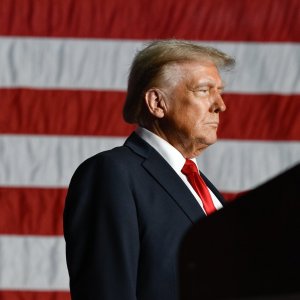Inflation is skyrocketing—here is Trump's strategy to fight it
By
Aubrey Razon
- Replies 3
Americans are feeling the strain of rising costs, with inflation hitting those on fixed incomes the hardest. President Trump has unveiled a plan to address this growing crisis.
Will his strategy provide the relief so many need?
In his inaugural address, President Trump outlined a firm approach to addressing inflation, which has reached significant levels following the pandemic.
His pledge to utilize the powers at his disposal aims to tackle rising costs and prices, addressing a key concern for many Americans.
The president’s strategy involves a broad approach, targeting different sectors of the economy with the goal of easing the cost of living.
Trump’s plan focuses on energy production, housing, healthcare, and labor, seeking to stimulate supply, reduce regulations, and boost workforce participation.

The administration aims to lower oil and gasoline prices by opening more federal land to drilling, including areas like the Arctic National Wildlife Refuge.
The policy, reflecting the "drill, baby, drill" message from Trump’s campaign, seeks to reduce gas prices by increasing the supply of American oil.
The effectiveness of this strategy remains a subject of debate.
Although increased production could potentially lower prices, global market factors and actions by other oil producers may offset these efforts.
Additionally, the Department of Energy predicts that oil prices will remain relatively stable in the coming years, indicating that increased production might not have a major effect on pump prices.
By simplifying environmental and other government rules, the administration aims to accelerate home construction and lower prices for consumers.
Housing has played a major role in inflation, with limited supply causing significant increases in home prices and rent.
While deregulation could provide some relief, experts warn that the effects on prices may be limited and take time to show.
Furthermore, other policies, such as tariffs on imports and stricter immigration measures, might unintentionally raise costs in the housing sector.
Work requirements for social programs may also be introduced to encourage higher workforce participation.
Supply chain disruptions, worsened by the pandemic, have contributed to inflation by increasing costs and delaying deliveries.
The government could take steps to address these challenges, such as permitting younger truck drivers to cross state lines, which could help lower freight costs.
Simplifying the complex web of providers, insurers, and middlemen could lead to lower expenses for consumers.
However, the administration's decision to revoke a Biden-era order aimed at reducing prescription costs raises questions about the overall strategy to make healthcare more affordable.
For home appliances, the administration may consider lowering energy efficiency standards, which could reduce costs in the short term but potentially increase energy consumption and environmental impact over time.
However, extending the tax cuts from his first term could lead to higher deficits, potentially contributing to inflationary pressures.
Inflation is a complex issue with no easy solutions, but by examining the proposed strategies and their potential impacts, we can better prepare for the financial road ahead.
While some policies may offer immediate relief, others could have long-term consequences that affect retirement planning and savings.
It's important to stay informed and adapt financial strategies accordingly.
Let's continue to support each other with knowledge, advice, and community engagement as we face the realities of a changing economy together.
In a related story, here is a review of Executive Orders issued by Trump in his first week back in office.
 How has inflation impacted your budgeting and lifestyle? Do you have tips for managing rising costs in retirement? Share your insights with us in the comments below.
How has inflation impacted your budgeting and lifestyle? Do you have tips for managing rising costs in retirement? Share your insights with us in the comments below.
Will his strategy provide the relief so many need?
In his inaugural address, President Trump outlined a firm approach to addressing inflation, which has reached significant levels following the pandemic.
His pledge to utilize the powers at his disposal aims to tackle rising costs and prices, addressing a key concern for many Americans.
The president’s strategy involves a broad approach, targeting different sectors of the economy with the goal of easing the cost of living.
Trump’s plan focuses on energy production, housing, healthcare, and labor, seeking to stimulate supply, reduce regulations, and boost workforce participation.

President Donald Trump has signed a memorandum directing federal agencies to find ways to combat high inflation. Image source: Donald J. Trump/Facebook.
Energy independence: A drill-down approach
A key element of Trump’s strategy is to increase domestic energy production.The administration aims to lower oil and gasoline prices by opening more federal land to drilling, including areas like the Arctic National Wildlife Refuge.
The policy, reflecting the "drill, baby, drill" message from Trump’s campaign, seeks to reduce gas prices by increasing the supply of American oil.
The effectiveness of this strategy remains a subject of debate.
Although increased production could potentially lower prices, global market factors and actions by other oil producers may offset these efforts.
Additionally, the Department of Energy predicts that oil prices will remain relatively stable in the coming years, indicating that increased production might not have a major effect on pump prices.
Regulatory rollbacks and housing costs
Trump’s plan also calls for a review of federal regulations that may be contributing to high housing costs.By simplifying environmental and other government rules, the administration aims to accelerate home construction and lower prices for consumers.
Housing has played a major role in inflation, with limited supply causing significant increases in home prices and rent.
While deregulation could provide some relief, experts warn that the effects on prices may be limited and take time to show.
Furthermore, other policies, such as tariffs on imports and stricter immigration measures, might unintentionally raise costs in the housing sector.
Labor market and supply chain solutions
To tackle labor shortages and wage pressures, the Trump administration is considering relaxing health and safety regulations and increasing funding for worker training.Work requirements for social programs may also be introduced to encourage higher workforce participation.
Supply chain disruptions, worsened by the pandemic, have contributed to inflation by increasing costs and delaying deliveries.
The government could take steps to address these challenges, such as permitting younger truck drivers to cross state lines, which could help lower freight costs.
Healthcare and home appliances
In healthcare, Trump's executive order targets “rent-seeking practices” that inflate costs.Simplifying the complex web of providers, insurers, and middlemen could lead to lower expenses for consumers.
However, the administration's decision to revoke a Biden-era order aimed at reducing prescription costs raises questions about the overall strategy to make healthcare more affordable.
For home appliances, the administration may consider lowering energy efficiency standards, which could reduce costs in the short term but potentially increase energy consumption and environmental impact over time.
Fiscal policy: Balancing budgets and tax cuts
Trump’s proposal to create a new department aimed at cutting federal spending by $1 trillion seeks to reduce the deficit and government demand for goods and services.However, extending the tax cuts from his first term could lead to higher deficits, potentially contributing to inflationary pressures.
Navigating inflation in retirement
For our GrayVine readers, understanding the nuances of Trump's inflation strategy is crucial.Inflation is a complex issue with no easy solutions, but by examining the proposed strategies and their potential impacts, we can better prepare for the financial road ahead.
While some policies may offer immediate relief, others could have long-term consequences that affect retirement planning and savings.
It's important to stay informed and adapt financial strategies accordingly.
Let's continue to support each other with knowledge, advice, and community engagement as we face the realities of a changing economy together.
In a related story, here is a review of Executive Orders issued by Trump in his first week back in office.
Key Takeaways
- President Donald Trump has signed a memorandum directing federal agencies to find ways to combat high inflation, focusing on areas such as housing, health care, energy, and workforce participation.
- Trump's approach to reducing inflation includes increasing oil production, deregulating industries, and cutting government spending, though experts have differing opinions on the effectiveness of these strategies.
- Economists caution that some of Trump’s policies, such as tariffs on imports and reducing immigration, could potentially contribute to inflation instead of reducing it.
- Despite some easing of inflation, Trump plans to take additional steps to lower consumer prices, including opening federal lands to energy drilling and potentially relaxing regulations on industries like housing and healthcare.






